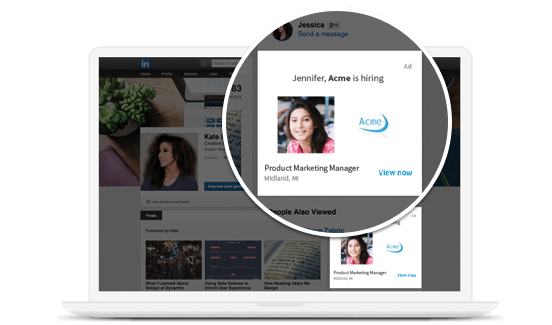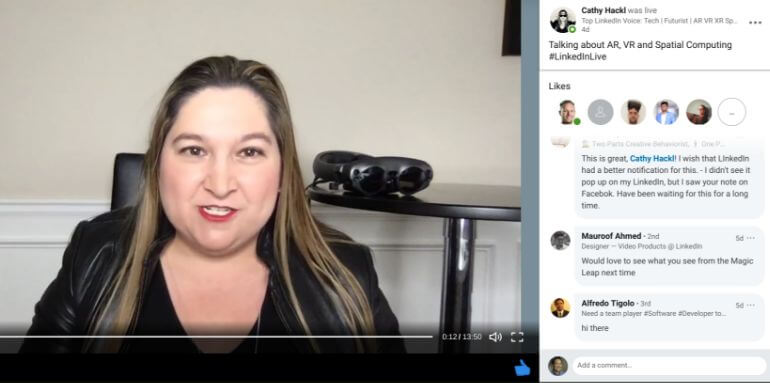Recently, TechCrunch broke the news that LinkedIn launched a live video broadcast service called LinkedIn Live. According to the article, “This week, the company is launching live video, giving people and organizations the ability to broadcast real-time video to select groups, or to the LinkedIn world at large.”
The feature is only available to beta users in the U.S. According to the TechCrunch article, users will soon be able to submit a request to gain access to the feature.
Cathy Hackl’s experience with LinkedIn Live
Cathy Hackl, a thought leader in the augmented reality and virtual reality industry and the #4 Top Voice on Linkedin went live recently:
View the on-demand archive of Cathy’s LinkedIn Live video.
Cathy’s prediction on LinkedIn Live:
“I predict that live video will increase engagement on the platform even more than native video, but will not replace the importance of native video. It will be an extremely useful tool for live events and also for earnings calls for public companies.”
When LinkedIn Live is opened to a wider set of users, I plan to request access. In the meantime, here are my predictions about LinkedIn Live.
1. Roll-out will be slow at first, but made available to all users by year-end 2019
Let’s consider a brief timeline of publishing on the LinkedIn platform:
October 2012: Celebrities (150 of them) were invited to publish on the platform. Users could “Follow” those celebrities.
February 2014: LinkedIn opens its publishing platform, initially to 25,000 English language users.
January 2015: The LinkedIn publishing platform is now available to 230 million members in all English-speaking countries.
The roll-out of LinkedIn Live will follow a similar sequence, but compressed into a shorter timeframe. During the first half of the year, LinkedIn will cautiously monitor broadcast quality, viewer engagement and viewer feedback.
We’ll see a large-scale opening of the feature in the third quarter of 2019. By year-end 2019, the feature will be available to all LinkedIn users in the U.S.
2. Initially, the LinkedIn algorithm will favor LinkedIn Live video.
Last year, the LinkedIn Engineering team took us behind the scenes in a fascinating post on creator-side optimization.
In the post, LinkedIn’s Bonnie Barrilleaux wrote, “we were in danger of creating an economy where all the gains in viral actions accrued to the top 1% power users, while the majority of creators who don’t receive much feedback were receiving less than ever.”
LinkedIn made adjustments to their newsfeed algorithm, to give favorability to creators (e.g., regular, non-celebrity users). Or as Bonnie wrote, the algorithm now quantifies the “value that the creator will receive from the viewer providing feedback on the post.”
I predict that LinkedIn will further tweak the algorithm to favor creators’ LinkedIn Live videos. We’re seeing this today, anecdoctally, with on-demand video: users report that posts with an uploaded video receive higher engagement than those without one.
Here’s one of my own posts — the use of video helped fuel engagement:
I believe LinkedIn will give preference to (in order):
LinkedIn Live video
On-demand video
Regular, link or text-based posts
I expect this to be a short-term bump to live video favorability. It will even out over the long term, as new formats or features are introduced to the platform.
I published on LinkedIn Pulse and shared on-demand video in the early days of those services. My experience: super-high engagement in the early days, which plateaued and diminished over time, as more users jumped on the bandwagon.
As an early adopter, you had an unfair advantage. But once everyone else is doing it, only the truly differentiated content wins. That will be the same with live video on LinkedIn.
3. The most common form of LinkedIn Live will be “talking head.”
Talking head video is common because it’s easy and convenient. I use talking head video on LinkedIn a few times per month. When I share a piece of content, I record a short video, then post the video along with the link.
It works!
But soon enough, others catch on. Before you know it, the newsfeed has more and more video, all with talking heads. We’ll see the same dynamic with LinkedIn Live: users will broadcast talking head video because it’s the easiest to do.
The winners with LinkedIn Live will seek new and creative uses for live video. Stephan Hovnanian, Social Strategy Consultant at Sprout Social, shared some ideas:
Depending on the engagement tools they make available, you could also hold live office hours with product education. Important: live is live. Unfiltered. Unpolished. Use it as raw material as a front line option to create a broader content strategy, not a final product
— Stephan Hovnanian (@stephanhov) February 15, 2019
4. LinkedIn Live could encroach on webinar platform vendors.
The TechCrunch article noted that LinkedIn Live will integrate with providers of live video streaming services. The article names Wirecast, Switcher Studio, Wowza Media Systems, Socialive and Brandlive as initial partners.
Imagine what happens when LinkedIn Live is made available to LinkedIn Company Pages.
You take the world’s largest community of business professionals, then give companies a way to connect with those professionals via a turnkey, live video broadcasting platform. You don’t need lead capture forms — LinkedIn already knows who its users are.
Add in a simple opt-in, however (e.g., “Check this box to schedule a demo of the product being demonstrated today”) and you have a turnkey video-webinar platform for B2B companies.
5. LinkedIn Live integrates with other products in the LinkedIn family.

“Work With Us” ads. Image via LinkedIn.
LinkedIn Talent Solutions has a product called “Work With Us” ads, which use display inventory across LinkedIn to target job seekers.
According to the product page, “Our recruitment ads get up to 50x higher clickthrough rates than typical recruitment ads — driving interested professionals to your jobs, Career Pages, and other places on LinkedIn.”
Imagine if these ads could drive clicks to LinkedIn Live broadcasts from hiring companies. They could broadcast from a town hall meeting or feature a “day in the life,” with a company executive walking the halls of headquarters.
These live broadcasts could appear in newsfeeds or even render from the ad unit itself. I think it’s a fantastic, soft-touch way for brands to gain mindshare with prospective employees.
And what about LinkedIn Learning, formerly known as Lynda.com? LinkedIn Live could be used to incorporate a live teaching element into the LinkedIn Learning curriculum.
Since LinkedIn Live and LinkedIn Learning are distinct user experiences, the initial use case is for LinkedIn Live could be to drive awareness and subscriptions of LinkedIn Learning.
High five 🙌 for Live.
I’ll be on the lookout for LinkedIn Live videos in my feed.
Related Post: 5 Reasons You Need to Be More Active on LinkedIn.
I manage a content marketing meetup in the Bay Area, so one idea is to use LinkedIn Live to broadcast some of our presentations.
What are your thoughts about LinkedIn Live and how would you use it if given the opportunity? Share your thoughts in the comments section below. Thanks for reading!


0 Comments on "LinkedIn Embraces Live Video: Predictions About LinkedIn Live"